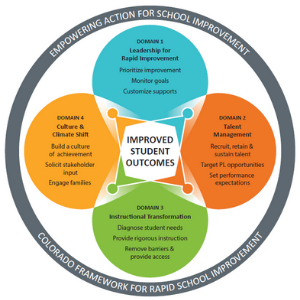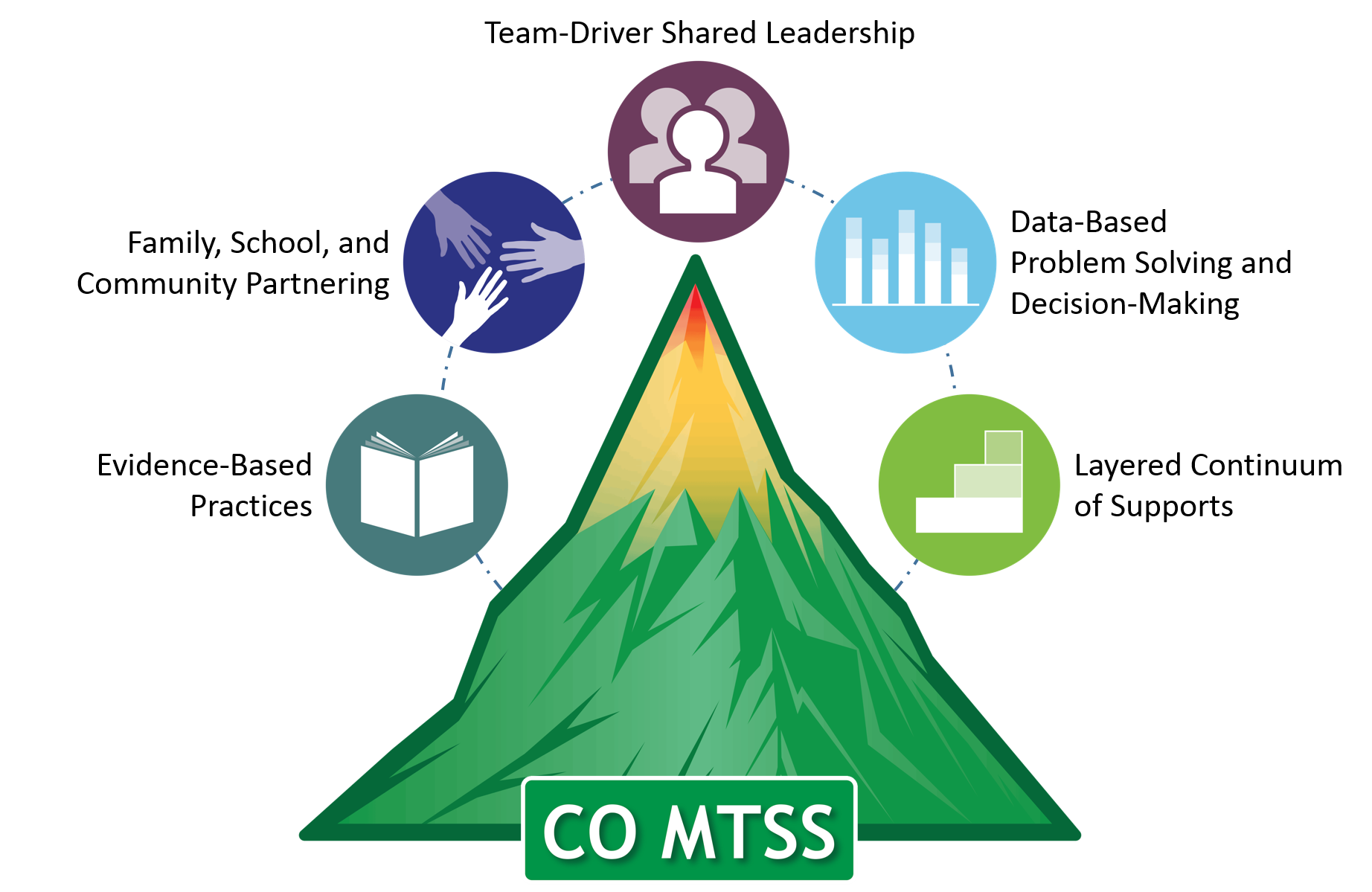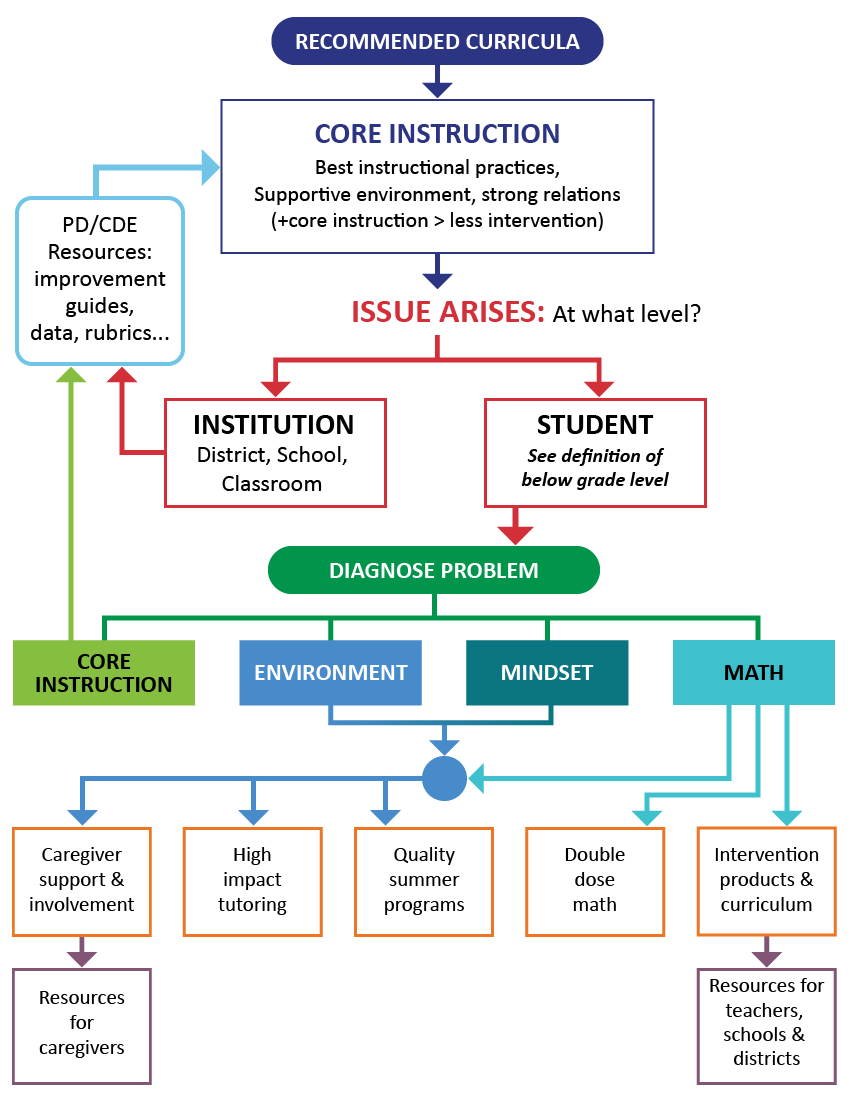You are here
Mathematics Intervention

New! Colorado Department of Education (CDE) has released free math interventions to support key areas in math education across the state. These comprehensive lessons include resources, assessments and activities designed for educators, families and out-of-school time professionals.
Mathematics Intervention
Some students need extra help to become proficient in mathematics. This help—which often gets called "intervention"—can include things like tutoring, different teaching techniques, mindset adjustments, and family/caregiver support. Some interventions are specific, like when one student needs help with one topic. Other interventions are more general, like when groups of students struggle on multiple topics. Either way, we recommend viewing intervention as a process, not just a product to be purchased. Intervention is more than software, manipulatives, or training that you can buy. Instead, intervention should focus on the specific needs of a student or group of students and working with that student or students and others in their support system to overcome their mathematical difficulties using the right tools for the job.
Data-Driven Interventions
Educators should use a variety of data to determine who needs intervention and what an intervention needs to focus on. In addition to student grades and test scores, your data should tell you things like:
- How the student(s) are engaged in the classroom,
- If the problem extends beyond a small number of students or topics, and
- If curriculum materials and instructional methods are aligned and effective.
CDE has a rubric and other tools to help you use data more effectively and improve your math outcomes. You are welcome to contact CDE mathematics specialists at mathacceleration@cde.state.co.us for help in making sense of your data and implementing interventions.
Tip: Use "Street Data"
"Street data" (and the book by the same name) refer to the data that tells us a lot about our students' backgrounds, abilities, and dreams. Instead of "top-down" measures like standardized test scores, street data are the "ground-level" stories, observations, and interactions that help us see what's right and good in our students and communities. Just because something isn't measurable doesn't mean it isn't valuable. This is especially true when using data to understand sources of inequity and to transform learning for students from marginalized communities.
Your data should now be pointing you in one or more directions. Below, we suggest creating a mathematics intervention plan that may include interventions at the system level, the classroom level, and/or the student level. A more complete flowchart for making intervention decisions is near the bottom of this page.
Developing a Comprehensive Mathematics Intervention Plan
Consider "system-level" interventions if your data suggests:
- A lack of data or poor data quality at the school level,
- Ineffective school-wide support structures for students and/or
- Weak connections with parents and communities.
Consider "classroom-level" interventions if your data suggests:
- Learning difficulties are widespread (over 10-20% of a class),
- Lessons and materials are misaligned with learning goals and/or
- Teaching practices are ineffective.

Consider "student-level" interventions if your data suggests:
- Learning difficulties are isolated (less than 10-20% of a class),
- A student or students struggle with a specific topic and/or
- Activities are needed for extra instructional time.
Improving Mathematics Teaching and Learning at the Classroom Level
As a general rule, if more than 10 or 20 percent of a class is in need of intervention, educators should suspect a problem with whole-class instruction. Here are some ways educators can attempt to improve mathematics learning across multiple topics for large groups of students.
Quality Curriculum

Curriculum should align with the standards and be logically sequenced to help students build new knowledge using what they already know. CDE maintains a list of high-quality materials and tools for reviewing materials yourself.
Effective Teaching Practices
Teachers need a variety of skills to help students with their needs. CDE has summaries of NCTM's effective mathematics teaching practices and equity-based teaching practices.
Professional Development
Teachers are learners, too, and need opportunities to develop in their profession. For teachers of mathematics, there are multiple organizations that provide professional learning opportunities for teachers.
Mathematics Interventions for Individual or Small Groups of Students
Ideally, students are consistently engaged with high-quality materials and methods for learning mathematics. When students struggle despite these experiences, here are resources for intervening with individual students or small groups.
Giving Students More Time and Attention
Some students are best served with additional learning time outside of the regular classroom.
- CDE's High-Impact Tutoring Program
- National Student Support Accelerator at Stanford University
- EdResearch on High-Impact Tutoring
- Harvard Study on Math Summer Programs
- "Double-Dose" Approaches / Supplemental Academic Instruction
Math-Focused Interventions
If you know what concept or skill a student is struggling with, there may be an intervention designed specifically to address it. Some curricular programs include these interventions, but some have been developed independently. Here are three resources for finding specific, math-focused interventions:
- What Work Clearinghouse Practice Guide: Assisting Students Struggling With Mathematics: Intervention in the Elementary Grades
- National Center on Intensive Intervention's "Academic Interventions Tools Chart"
- Evidence-Based Intervention Network
CDE will be providing additional resources as we collect and/or develop them.
Resources for Families and Caregivers
Families can provide important support to a struggling math student. Here are some resources:
- The Mathematics Education Collaborative offers suggestions for how family members and caregivers can ask productive questions.
- List of questions that will help keep the thinking and learning in the hands of your child.
- Jo Boaler's "Advice for Families" answers the question: What can parents do to transform math for their children? (Ahora disponible en Español: Consejos para padres, de la profesora Jo Boaler)
- In the "Parents Supporting Mathematics Learning Video," teachers and administrators give advice to parents and guardians supporting their child's learning in math.
- The National Council of Teachers of Mathematics (NCTM) and the Hunt Institute have produced a series of videos to enhance understanding of the mathematics that students need to succeed in college, life and careers.
- Helping Your Child Learn Mathematics
- List of Intervention Programs and Resources by EDC
- Family Math for Parents by NAFCE
Math Intervention Guidance Flowchart
When students face math challenges and require intervention, diagnosing the root problem is crucial. Similar to how a doctor would not prescribe right arm casts for everyone in an emergency room, in education, educators must address the varying underlying issues of student performance. The following flowchart serves as a tool to examine programs, helping to pinpoint the most impactful course of action.











Connect With Us





